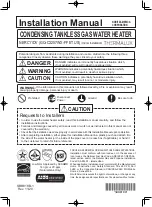
58
Modulating Gas System
The Modulating Gas System is directly controlled from the MUA Board at connector J32 pin 7(+) and 16(-).
A modulating 0-24V DC signal is utilized to modulate the gas valve signal. The signal is a 16 kHz full-wave
rectified signal.
The Modulating Gas System consists of an Intake Temp Sensor, a Discharge Temp Sensor, a Space
Temp Sensor (only on space temperature control options), and modulating gas valve(s). The intake air
sensor, the space sensor, or a combination of the two can be used to give a call for heat signal to the MUA
board.
The MUA board uses a PID loop and checks the difference between the temperature sensor readings in
order to modulate the heat appropriately.
• For kitchen MUA heating applications, intake air setpoint should be set at 45°F, whereas the discharge
setpoint should be set at 55°F. The defaults may be adjusted per field conditions.
• For all other applications, the setpoint should be set appropriately based on end-user preferences and
on-site conditions.
High Temperature Limit
One of the backup safety devices is the high-temperature limit lockout. This temperature sensor measures
the temperature inside the unit, downstream of the burner. If the factory-set temperature of 170°F is
exceeded, it will signal the FSC to turn off the burner. This requires a manual reset of the high-temperature
limit. Refer to
Pilot Adjustment
Figure 26 - Pilot Assembly
1. Restart the fan and check the gas supply pressure at the
inlet gas gauge upstream of all electronic valves. The inlet
pressure should be
7 - 14 inches wc (7 inches wc - 5 psi
on Size 4-5 heaters)
. If the inlet pressure is too high,
install an additional pressure regulator external to the unit.
2. Open the field-installed manual gas shut-off valve.
3. Close the ball valve located inside the cabinet.
4. Call for heat using the HMI
Service > Test Menu > Test
Heating > High Fire.
If the pilot does not light, purge the
pilot line. If air purging is required, disconnect the pilot line
at the outlet of the pilot valve.
5. Check the
pilot flame voltage
on the HMI. The voltage
reading should be
12V-15V DC
.
The Flame LED on the
Flame Safety Controller should be illuminated too. A weak
pilot flame can be caused by low gas pressure or a dirty
pilot orifice.
6. To adjust the pilot flame, remove the cap from the pilot
adjustment screw on the combination gas valve, refer to
. Increase the pilot gas flow by turning the screw
counter-clockwise. Decrease the pilot gas flow by turning the screw clockwise. The flame signal
voltage should read
12V-15V DC
on the HMI under
Service > Test Menu > Test Heating
.
7. Once the pilot has been established, open the main manual gas shut-off valve downstream of the
electronic valves. Check to make sure that the main gas valve opens and gas flows to the burner.
Spark Connection
Flame Rod
Connection
Clearance = 2.96”
Flame Rod
Pilot Tube
Connection
Summary of Contents for MUA Controls
Page 82: ...82 Notes ...
Page 83: ...83 CLEANING MAINTENANCE RECORD Date Service Performed ...
















































